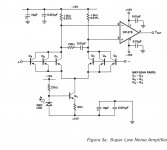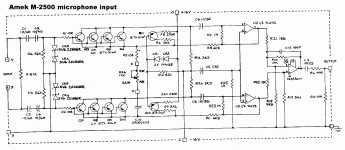Hi guys, im looking some info about how to build some Low Noise Preamp for microphones.
Im looking for that because i want to use it with my video camera, i want to get an better sound.
Thanks in advance.
Im looking for that because i want to use it with my video camera, i want to get an better sound.
Thanks in advance.
You can build a preamp using a low noise FET like the SK170.
Before anyone can help, you need to tell us more.
What is the impedance of the microphones?
Balanced or unbalanced input?
What kind of level does the recording device want to see?
Please provide as much information as you can.
Before anyone can help, you need to tell us more.
What is the impedance of the microphones?
Balanced or unbalanced input?
What kind of level does the recording device want to see?
Please provide as much information as you can.
Check out Scott Wurcer's article in "Linear Audio," volume 1. He demolishes the common wisdom about the best choices for FETs.
You can build a preamp using a low noise FET like the SK170.
Before anyone can help, you need to tell us more.
What is the impedance of the microphones?
Balanced or unbalanced input?
What kind of level does the recording device want to see?
Please provide as much information as you can.
will try to send more info ASAP, but for now, the mics are low impedance ones like RODE NTG2, NTG3, are balanced ones and operated from AA battery to 48V phantom.
i think that the impedance will be 200-400 ohms (will change if use battery or phantom).
Imput Impedance of the recorders are like 1kΩ
So you're looking for a balanced low-noise preamp circuit.
This is something I'm rather experienced with, because I actually manufactured a 2-mic preamp in early 2000 to be used with professional low-noise microphones, like the ones you mention or better, so you could improve on amateur camera's audio.
It is not easy task to do as DIY, which is what the first working unit was in the beginning. So do consider existing products (not mine because it's no longer made) first. They are not too expensive, considering what you would need to make your own.
The most difficult parts are not the preamp circuit, but the 48v phantom supply and the metal box you will need to put all things in. It has to be a metal box and it has to be light, or they will be a burden to carry around.
In any case, you should investigate which balanced low-noise specific chips are still being made. I used the SSM2017, which no longer exists. It should be DIP8, as SMD chips are hard to handle, both to solder and to make a pcb for.
This is something I'm rather experienced with, because I actually manufactured a 2-mic preamp in early 2000 to be used with professional low-noise microphones, like the ones you mention or better, so you could improve on amateur camera's audio.
It is not easy task to do as DIY, which is what the first working unit was in the beginning. So do consider existing products (not mine because it's no longer made) first. They are not too expensive, considering what you would need to make your own.
The most difficult parts are not the preamp circuit, but the 48v phantom supply and the metal box you will need to put all things in. It has to be a metal box and it has to be light, or they will be a burden to carry around.
In any case, you should investigate which balanced low-noise specific chips are still being made. I used the SSM2017, which no longer exists. It should be DIP8, as SMD chips are hard to handle, both to solder and to make a pcb for.
I have used tl084 on a mixer I designed for mics and line level.
You will need to carefully decouple the tl084 and also have good power supplies to stop noise getting in. An RF filter on the front end would be a good idea too, you dont want radio breaking through.
You will need to carefully decouple the tl084 and also have good power supplies to stop noise getting in. An RF filter on the front end would be a good idea too, you dont want radio breaking through.
So you're looking for a balanced low-noise preamp circuit.
This is something I'm rather experienced with, because I actually manufactured a 2-mic preamp in early 2000 to be used with professional low-noise microphones, like the ones you mention or better, so you could improve on amateur camera's audio.
It is not easy task to do as DIY, which is what the first working unit was in the beginning. So do consider existing products (not mine because it's no longer made) first. They are not too expensive, considering what you would need to make your own.
The most difficult parts are not the preamp circuit, but the 48v phantom supply and the metal box you will need to put all things in. It has to be a metal box and it has to be light, or they will be a burden to carry around.
In any case, you should investigate which balanced low-noise specific chips are still being made. I used the SSM2017, which no longer exists. It should be DIP8, as SMD chips are hard to handle, both to solder and to make a pcb for.
Thanks!
about the case i was thinking abt use aluminium material for it!
im now trying to figure how many gain need to have in my PRE :S can someone please tellme some tips or some doc that i can read about that? i think that the gain need to be as high as possible without having noise, right? that can be found in the datasheet of the opamp, right?
The gain of your stages needs to match up to 0db for line level out of your pre amp into a power amp.
Different sources will need different amounts of gain.
Different sources will need different amounts of gain.
i dont will use any power amp, mainly i want to connect the out of the PRE into some digital camera or portable recorders. Maybe i can set 3 differents gains (hi, med, low) so can use it into diferents units (cameras, portable recorders, amps)...
THAT Corporation Audio Technology
The most attractive IC solution would have to be the THAT CORP 1510 or 1512 chips. There is plenty of application data available on the site.
Keith
The most attractive IC solution would have to be the THAT CORP 1510 or 1512 chips. There is plenty of application data available on the site.
Keith
What if you get a new mic!
Mic pre amps usually have gain ranges from 20 to 70 db (a lot of them also include 20 db pads right at the input for hot signals, like close trombones). Your active mics will need 20 to 40db some dynamics and ribbons need 40 to 70 db.
Mic pre amps usually have gain ranges from 20 to 70 db (a lot of them also include 20 db pads right at the input for hot signals, like close trombones). Your active mics will need 20 to 40db some dynamics and ribbons need 40 to 70 db.
Amek M2500 cheap to build ad very very nice......only tricky part is 1K rev log pot....but you can use rev log and adjust gain contraclockwise...
Regards, Taj
Regards, Taj
- Status
- Not open for further replies.
- Home
- Amplifiers
- Solid State
- Looking for info about low-noise preamplifier

